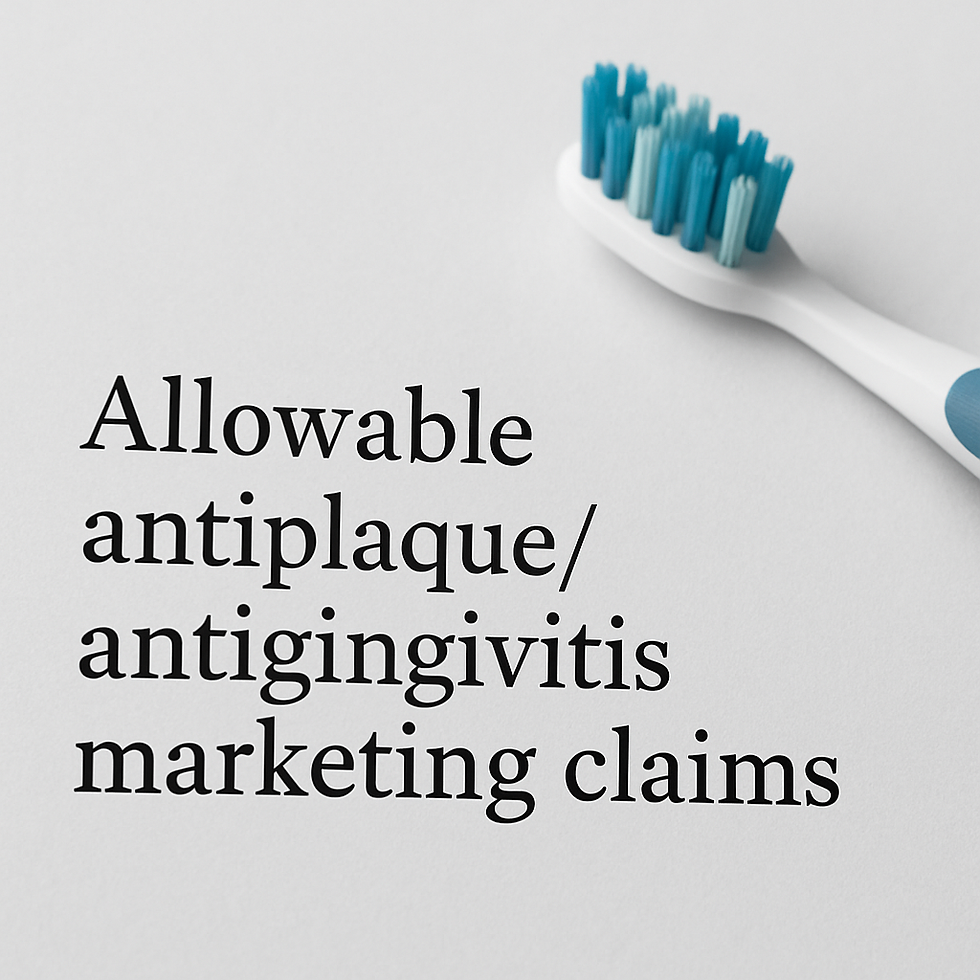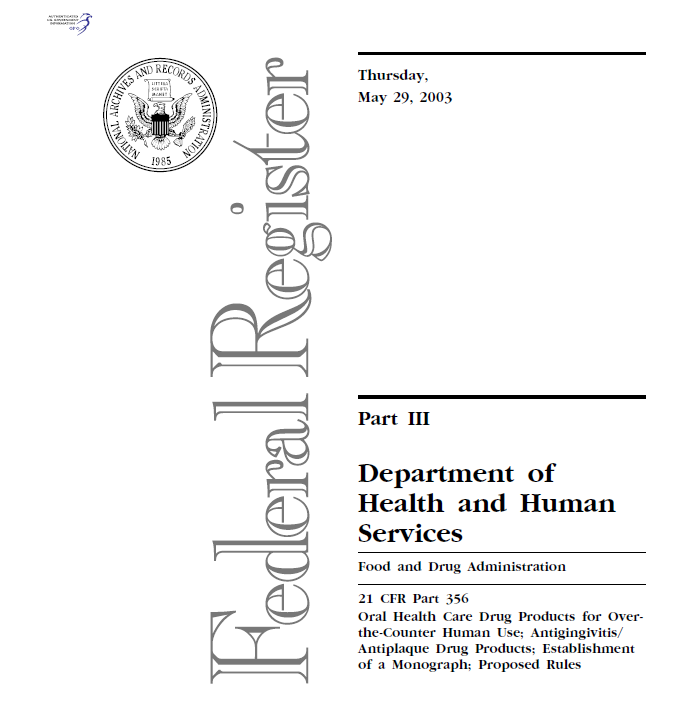Mouthwashes: How Ingredients and Marketing Claims Can Trigger Clinical Trials and NDA Requirements
- Evan Howard
- May 24
- 5 min read
Mouthwashes are a staple in oral hygiene routines, promising everything from fresher breath to cavity prevention and even gum disease reduction. But behind the minty freshness and bold marketing claims lies a complex regulatory landscape, where both the ingredients used and the promises made can determine whether a product glides smoothly to market or faces the rigorous scrutiny of clinical trials and New Drug Applications (NDAs). Understanding this process is crucial not only for manufacturers but also for consumers who want to know what goes into the products they use daily.

The Mouthwash Monograph: A Regulatory Foundation
The U.S. Food and Drug Administration (FDA) regulates over-the-counter (OTC) mouthwashes under a system known as the "monograph." The monograph acts as a kind of recipe book and rule set, specifying which active ingredients are generally recognized as safe and effective (GRASE) for particular uses, such as reducing plaque, fighting gingivitis, or preventing cavities. If a mouthwash contains only these approved ingredients at specified concentrations and makes only approved claims, it can be marketed without pre-approval from the FDA.
For example, sodium fluoride, stannous fluoride and cetylpyridinium chloride (CPC) are found in mouthwash proven to reduce plaque and gingivitis. In addition to active ingredients, the monograph also covers certain allowable claims, such as "helps prevent cavities" or "reduces plaque," provided these are supported by scientific evidence.
When Ingredients Trigger Clinical Trials
Not all mouthwashes fit neatly into the monograph framework. If a manufacturer wants to use a new or unapproved active ingredient, say a novel botanical extract or a new antimicrobial compound, this falls outside the monograph's safe harbor. In such cases, the manufacturer must submit an NDA, which requires clinical testing to demonstrate the product's safety and efficacy for its intended use.
Recent studies illustrate this point well. For instance, a mouthwash containing a novel combination of amine, zinc lactate, and fluoride underwent both in vitro and clinical efficacy testing to substantiate its antibacterial and anti-gingivitis claims. Similarly, mouthwashes featuring unique herbal extracts or alternative actives, such as curcumin or Sambucus williamsii, have been evaluated in randomized, placebo controlled clinical trials to establish their effectiveness and safety before being allowed broader marketing.
The Power and Pitfalls of Marketing Claims
Ingredients are only half the story. The claims a company makes about a mouthwash can be just as important in determining regulatory requirements. The FDA draws a clear line between cosmetic claims (such as "freshens breath") and drug claims (such as "prevents gingivitis" or "kills 99% of germs that cause plaque"). If a mouthwash makes claims that imply it treats, prevents, or mitigates disease, it is considered a drug, even if the ingredients themselves are otherwise allowed for cosmetic use.
For example, Listerine's claim to "kill 99% of germs that cause common oral ailments" is a strong drug claim, which must be substantiated by clinical data. If a company overreaches, making bold or misleading health claims without sufficient evidence, they may face regulatory action, lawsuits, or be forced to withdraw the product from the market.
This is not just theoretical. There have been instances where marketing claims led to legal challenges, such as allegations that a mouthwash could increase the risk of certain health conditions if used daily, despite being marketed as safe and effective. Such situations highlight the importance of substantiating claims with clinical evidence, especially when venturing beyond the boundaries of the monograph.
Cosmetic vs. Drug: Where the Line Is Drawn
The distinction between a cosmetic and a drug mouthwash is critical. Cosmetic mouthwashes, which promise only to freshen breath or clean the mouth, are subject to less stringent regulations. However, as soon as a product claims to prevent or treat a disease (like cavities, gingivitis, or oral ulcers), it is regulated as a drug. This triggers the need for clinical trials to prove safety and efficacy, as well as an NDA if the product's formulation or claims are not covered by the monograph.
This is particularly relevant for compounded mouthwashes, such as "magic mouthwash," which often contain ingredients like antihistamines, anesthetics, and antacids to treat oral mucositis or mouth sores. Because these are intended to treat a medical condition, they are considered drugs and must be prescribed and compounded under the supervision of a healthcare professional.
Clinical Trials: The Gold Standard for Substantiation
When either ingredients or claims fall outside the monograph, clinical trials become essential.
These trials are designed to:
Demonstrate the product's safety for consumer use.
Prove the efficacy of the mouthwash for its intended claims.
Provide robust evidence to support marketing and advertising claims, which is increasingly important as consumers and regulators demand transparency and accountability.
Clinical trials for mouthwashes typically involve both laboratory (in vitro) testing and human (in vivo) studies. For example, a new mouthwash might be tested in the lab for its ability to kill oral bacteria, followed by a clinical study to see if it actually reduces plaque or gingivitis in real-world use over several months. The data generated must be statistically sound and able to withstand scrutiny from regulatory authorities and advertising standards agencies.
The NDA Process: When a New Drug Application Is Required
If a mouthwash cannot be marketed under the existing monograph-either due to novel ingredients or unapproved claims-the manufacturer must submit an NDA. This is a comprehensive process that includes:
Detailed descriptions of the product's formulation and manufacturing process.
Results from preclinical and clinical studies demonstrating safety and efficacy.
Proposed labeling and marketing claims, which must be supported by the data.
The NDA process is time consuming and expensive, but it is the only pathway for bringing truly innovative mouthwash products to market when they fall outside the established monograph system.
Marketing and Advertising: The Need for Evidence
In today's competitive market, companies are eager to differentiate their mouthwash products with bold claims and innovative ingredients. However, advertising authorities and regulatory agencies are increasingly vigilant in ensuring that all claims are truthful and substantiated by evidence. This means that even if a product is technically compliant with the monograph, any additional claims, such as "clinically proven to whiten teeth" or "reduces the risk of oral cancer," must be backed by clinical data.
Failure to do so can result in regulatory action, consumer lawsuits, and damage to brand reputation. For example, if a mouthwash is marketed as reducing the risk of certain cancers but lacks robust clinical evidence, the manufacturer can face significant legal and financial consequences.
Navigating the Regulatory Maze
The world of mouthwashes is more than just fresh breath and pretty packaging. Both the ingredients used and the marketing claims made can dramatically affect whether a product is classified as a cosmetic or a drug, and whether it can be marketed freely or must undergo clinical trials and the NDA process. For manufacturers, it is essential to understand the FDA monograph, carefully select ingredients, and ensure that all claims are substantiated by rigorous clinical evidence. For consumers, it pays to be aware of what those claims really mean-and what kind of testing and regulation stands behind them.
By staying informed and compliant, companies can bring safe, effective, and innovative mouthwash products to market, while earning the trust of regulators and consumers alike.
Howard Law is a business, regulatory and M&A law firm in the greater Charlotte, North Carolina area, with additional services in M&A advisory and business brokerage. Howard Law is a law firm based in the greater Charlotte, North Carolina area focused on business law, corporate law, regulatory law, mergers & acquisitions, M&A advisor and business brokerage. Handling all business matters from incorporation to acquisition as well as a comprehensive understanding in assisting through mergers and acquisition. The choice of a lawyer is an important decision and should not be based solely on advertisements. The information on this website is for general and informational purposes only and should not be interpreted to indicate a certain result will occur in your specific legal situation. Information on this website is not legal advice and does not create an attorney-client relationship. You should consult an attorney for advice regarding your individual situation. Contacting us does not create an attorney-client relationship. Please do not send any confidential information to us until such time as an attorney-client relationship has been established.




Comments